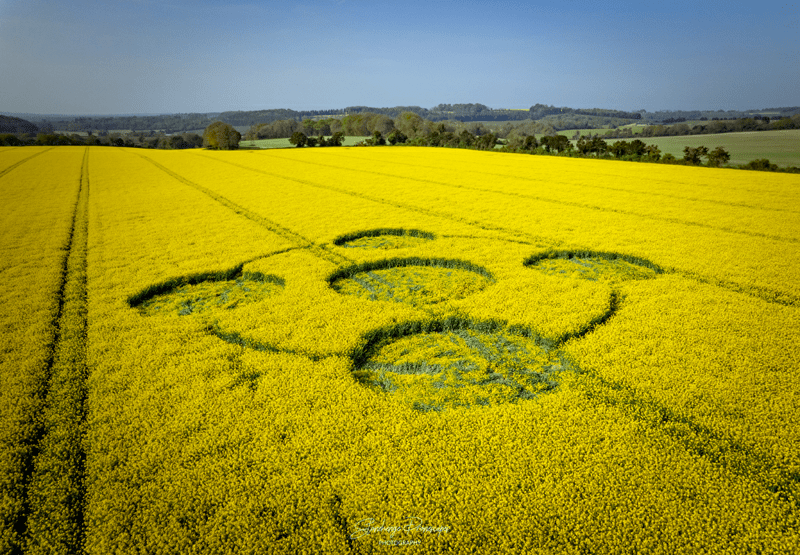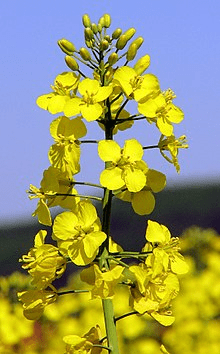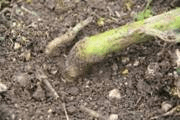
It has arrived - the first crop circle of 2022. At this time of year the circle presents itself in the startlingly vibrant yellow flowered crop, oil seed rape (canola), much used for cooking and in health products.

Enmill Barn, near Crabwood, Winchester, Hampshire. Reported 24th April 2022
Oil Seed Rape (Canola) 85 feet (25.9m) overall.

Enmill Barn, Nr Crabwood, Winchester, Hampshire. Reported 24th April 2022
Oil Seed Rape (Canola) 85 feet (25.9m) overall.
Images copyright © StonehengeDronescapesPhotography
The term "rape" derives from the Latin word for turnip, rapa or rapum, cognate with the Greek word rhapys.
Wikipedia tells us that 'Crops from the genus Brassica, including rapeseed, were among the earliest plants to be widely cultivated by mankind as early as 10,000 years ago. Rapeseed was being cultivated in India as early as 4000 B.C. and it spread to China and Japan 2000 years ago.'
'One of the most versatile of all plants, oil seed rape is also used as diesel fuel, either as biodiesel in heated fuel systems, or blended with petroleum distillates for powering motor vehicles. Biodiesel may be used in pure form in newer engines without engine damage and is frequently combined with fossil-fuels. Historically it was used in limited quantities due to high levels of erucic acid. Processing of rapeseed for oil production produces rapeseed meal as a by-product. This by-product is a high-protein animal feed - competitive with soybean. The feed is employed mostly for cattle feeding, but is also used for pigs and poultry. However, natural rapeseed oil contains 50% erucic acid and high levels of glucosinolates that significantly lowers the nutritional value of rapeseed press cakes for animal feed.'

Oil seed rape flower
The flowers have a most pungent smell and if you walk through it, you will find it is hard to get the pollen off your hair or clothes.
As regards detective work, it is the easiest crop for sussing out the Goodies or Baddies.

In 2010 a most glorious formation arrived during a week-end just below Winton windmill in Wiltshire. It contained the most complex geometry, almost exactly bearing a likeness to Russian born physicist Leonard Euler's equation said to be one of the most complex, and indeed, possibly not fully understood by Euler himself. See diagram below.

Winton Windmill ~ Wiltshire


Left: Base of undamaged stalk.
Right: Root of undamaged stalk twisted by the `force`
'Having woken at 4am one morning and unable to get back to sleep I decided to drive down to Wiltshire and see the formation for myself. It had been raining heavily overnight and despite having stopped by the time I arrived, I had forgotten how much water the yellow petals retain. The crop stood about 5 ft tall and in no time at all I was drenched from head to toe and my Wellington boots were full of water that had trickled relentlessly downwards. In addition I had forgotten to bring my aerial photograph and as the formation could not be seen from the ground - only from the air or the windmill and this had been closed the week-end the formation appeared - I simply could not find it and was getting wetter and wetter. Not surprisingly not many people were happy to answer my early morning mobile telephone calls until Julian Gibsone nobly answered his and gave me the necessary directions. The outer ring was much trampled and did not provide me with the information I needed. However, the lay of the crop was remarkable, lying in a criss-crossing herring bone manner. I made my way inwards to areas that had been untouched and found what I was looking for; an unbroken stem without any cracks above or below. In order to ascertain this properly, it is necessary to dig away the soil from some way down around the stem. Holding my camera with soil covered, wet and slippery hands, I managed to get a photograph. Now soaked to the skin, and hoping that no-one was around, I did a quick strip, discarding first my sweater, replacing it with a jacket that came down to my knees and hid the fact that I had also discarded my jeans. Luckily I did not have to stop for anything on my way home so modesty was preserved! Definitely worth the effort!'
The whole article can be found on my web site under Articles Worth The Effort (2010)
So, what will this summer bring us? This is one of the reasons that croppies start to get excited at this time of year, wondering when the first circle will arrive and what will follow and when!
Now that travellers are free to come and go as they like, we welcome our overseas visitors once again. Just one caveat, PLEASE treat the circles with respect; the fields are the livelihood of the farmers who own them.
Many of them have unfortunately had bad experiences with visitors trampling and destroying their crops and as a result have now decided to mow out any circle immediately it appears; whilst a few others are still happy for people to visit and enjoy them, whilst taking the utmost care not to damage them. Please always get in touch with the farmer on to whose land you wish to visit (one time it took me half a day to find the farmer).Walk down the tramlines (lines in the fields used by farmers for sowing, reaping etc.), taking care to walk down the correct tramline which will take you straight into the field, thus making sure you have not had to trample over any crop to reach the circle. The easiest way to discover the correct tramline is to find a vantage point from which you can see the circle and then count the number of tramlines needed to take you directly into the circle.
I am sure many of you do this already, so good on you!
